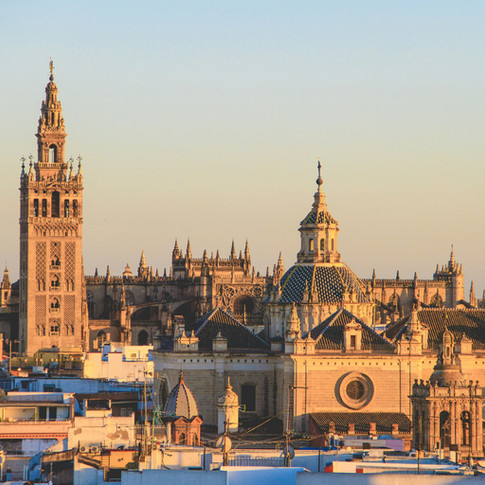- Travel Enthusiast
- Nov 3
- 7 min read
Updated: Nov 8
THE BEST PLACES TO VISIT IN SOUTHERN SPAIN

From the Moorish palaces of Granada to the golden beaches of the Costa del Sol, Southern Spain is a region of color, rhythm, and heritage. Its cities tell stories through grand cathedrals, intricate architecture, and lively plazas, while the countryside reveals whitewashed villages and timeless landscapes.
Every corner of Andalusia feels distinct yet connected, bound by the same warmth, spirit, and love for life that make this region one of Spain’s most unforgettable.
Here are some of the best places to visit in Southern Spain, where every city and village tells its own story of heritage and charm.
*Disclaimer: This post contains affiliate links to products and services we recommend. If you purchase through these links, we may earn a small commission at no additional cost to you. This helps us continue to create helpful travel guides. Thank you for your support.*
GRANADA
Granada captures the essence of Andalusia, a city shaped by its Moorish past and mountain backdrop. The Alhambra, one of Spain’s greatest landmarks, sits above the city as a masterpiece of Islamic architecture, with courtyards, fountains, and palaces that tell centuries of history.
Down below, wander through the Albaicín quarter, which preserves its medieval layout with narrow streets that open to hidden viewpoints and tiled houses overlooking the fortress. Then, cross the Darro River to Sacromonte, a hillside neighborhood known for its cave homes and traditional flamenco shows that keep Granada’s heritage alive.
When you’re ready to relax, Granada’s tapas culture is one of the best in Spain – order a drink and you’ll often get a small plate for free.
How to get there: Granada has a small airport, but many visitors arrive by train or bus from Seville or Málaga (2–2.5 hours).
Best time to visit: April–June or September–October for pleasant weather and fewer crowds.
Tip: Book Alhambra tickets several weeks in advance and plan your visit early in the day.
SEVILLE
Few cities embody Southern Spain’s spirit like Seville. The Seville Cathedral, one of the world’s largest Gothic churches, and the Giralda Tower showcase the city’s grand past, while the Real Alcázar stands out for ornate tilework and lush gardens.
Stroll through the Barrio Santa Cruz, a maze of flower-filled courtyards and shaded alleys, then head to the Plaza de España, built for the 1929 Ibero-American Exposition – one of Spain’s most photographed landmarks. In the evening, cross the river to Triana, the birthplace of flamenco, and catch a live show.
Seville also shines during Semana Santa (Holy Week) and Feria de Abril, two of Spain’s most important festivals that fill the city with processions, music, and colorful costumes.
How to get there: Seville Airport has regular domestic and European flights. The AVE high-speed train connects it to Madrid in under 2.5 hours and to Córdoba in 45 minutes.
Best time to visit: March–May and September–October. Summers can be extremely hot, often above 38°C (100°F).
Tip: Most main attractions are within walking distance, so wear comfortable shoes – Seville’s cobbled streets and hidden alleys are best explored on foot.
CÓRDOBA
Once the capital of the Islamic Caliphate, Córdoba was among the most advanced cities in medieval Europe. Its Mezquita-Catedral remains one of Spain’s most extraordinary monuments – a forest of red-and-white arches and intricate mosaics that blend Moorish and Christian influences.
Step outside into the Jewish Quarter (Judería), where narrow cobblestone streets lead to flower-decked patios, traditional houses, and small artisan shops. The Roman Bridge and Alcázar de los Reyes Cristianos provide perfect sunset views along the Guadalquivir River.
In May, the Patio Festival transforms Córdoba into a living museum of color and fragrance as residents open their courtyards to visitors – one of Andalusia’s most beautiful traditions.
How to get there: Córdoba is connected to Seville, Granada, Madrid, and Málaga by high-speed train (AVE), making it an easy day trip from either Seville or Málaga.
Best time to visit: April–June for warm weather and festival season.
Tip: Consider a guided tour that combines the Mezquita, Jewish Quarter, and Alcázar to save time and money.
MÁLAGA & COSTA DEL SOL
Málaga combines coastal energy with cultural depth. Once known mainly as a beach destination, it’s now a thriving city of museums, historic sites, and Mediterranean charm. Highlights include the Alcazaba – a Moorish fortress overlooking the port, the Roman Theatre, and the Picasso Museum, celebrating the city’s most famous son.
The surrounding Costa del Sol stretches east and west, lined with beaches, promenades, and towns that each offer their own vibe. Nerja stands out for its dramatic sea caves and the Balcón de Europa viewpoint, while Frigiliana, perched above, is one of Andalusia’s prettiest villages. To the west, Marbella blends old-town character with upscale resorts, and Estepona offers a quieter, more local atmosphere.
How to get there: Málaga has one of Spain’s busiest airports and an excellent rail network connecting it to Seville, Córdoba, and Madrid.
Best time to visit: April–October. July and August bring heat and crowds, so late spring or early autumn is ideal.
Tip: If you plan to explore the Costa del Sol, choose Málaga as your base – it has great connections for easy day trips.
RONDA & THE WHITE VILLAGES (PUEBLOS BLANCOS)
Perched dramatically above the El Tajo Gorge, Ronda is one of Spain’s most striking towns. The Puente Nuevo Bridge connects the old and new quarters, offering unforgettable views of the surrounding countryside. Explore its cobbled streets, the Mondragón Palace, and the Plaza de Toros, one of Spain’s oldest bullrings.
Ronda also serves as a gateway to the Pueblos Blancos, a series of whitewashed mountain villages scattered across the Sierra de Grazalema. Grazalema, Zahara de la Sierra, and Setenil de las Bodegas – where homes are built directly into rock – are among the most picturesque.
These villages are perfect for scenic drives or short hikes, offering glimpses of traditional Andalusian life surrounded by olive groves and limestone cliffs.
How to get there: Ronda is about 2 hours by car from Seville or Málaga. Buses also run daily, but having a car allows you to explore nearby villages freely.
Best time to visit: March–June or September–October, when temperatures are ideal for walking and outdoor activities.
Tip: Stay overnight in Ronda to enjoy the town once the day visitors have gone and the gorge glows at sunset.
CÁDIZ
Founded by the Phoenicians over 3,000 years ago, Cádiz is one of Europe’s oldest continuously inhabited cities – and still one of its most atmospheric. The compact old town is a maze of stone alleys opening onto squares like Plaza de las Flores and Plaza de San Juan de Dios, lined with tapas bars and lively cafés.
Visit the Cádiz Cathedral, climb Torre Tavira for panoramic views, and walk the coastal promenade to La Caleta Beach, where locals gather at sunset. The city’s Carnival in February is one of Spain’s biggest celebrations, with parades, humor, and music filling the streets.
Beyond the city, the Costa de la Luz offers long, untamed beaches and towns like Conil de la Frontera and Tarifa, where the Atlantic meets the Mediterranean.
How to get there: Cádiz is around 1.5 hours from Seville or Jerez by car or train.
Best time to visit: May–October for warm weather and lazy beach days, or February if you want to experience the city at its most festive during Carnival.
Tip: Plan your visit during the week if possible – Cádiz feels more local and relaxed once the weekend crowds from Seville and Jerez fade away.
ALMERÍA & THE TABERNAS DESERT
Almería shows a more rugged side of Southern Spain, where desert landscapes meet the Mediterranean coast. The Cabo de Gata-Níjar Natural Park is the region’s highlight, a protected stretch of volcanic cliffs, turquoise coves, and quiet fishing villages like San José and Agua Amarga. It’s perfect for hiking, swimming, or simply enjoying a slower pace surrounded by nature.
Inland, the Tabernas Desert offers dramatic, cinematic scenery that once served as a backdrop for classic Western films. Today, you can explore the landscape on 4x4 tours, visit old movie sets, or simply enjoy the stillness of this sunbaked terrain.
How to get there: Almería has an airport and train connections to Granada and Málaga. A car is best for exploring Cabo de Gata’s remote beaches.
Best time to visit: April–June or September–October, when it’s warm but not too hot for hiking.
Tip: Bring sun protection – Almería is one of Europe’s driest and sunniest regions.
JEREZ DE LA FRONTERA
Jerez captures the heart of Andalusia, known for its deep traditions, graceful horses, and powerful flamenco. At the Royal Andalusian School of Equestrian Art, riders perform elegant routines that showcase the city’s equestrian heritage, while its small tablaos offer authentic flamenco shows that reveal the region’s soul.
In May, the Feria del Caballo fills Jerez with color, carriages, and music. Locals gather in traditional dress, dancing and celebrating well into the night – a perfect reflection of Andalusia’s festive spirit.
How to get there: Jerez has its own airport and train connections to Cádiz and Seville, both less than an hour away.
Best time to visit: April–June, when the Feria del Caballo takes place and the weather is warm but comfortable.
Tip: Combine Jerez with a visit to nearby Cádiz or Arcos de la Frontera for a blend of culture, history, and Andalusian charm.
START YOUR ADVENTURE
Every part of Southern Spain has its own rhythm – from the energy of its cities to the slower pace of its villages and the easy charm of its coast. Traveling through Andalusia reveals a region full of contrasts, where history, culture, and daily life blend in a way that feels effortlessly natural.
Southern Spain leaves a lasting impression – through its landscapes, its traditions, and the unmistakable warmth of its people.



































